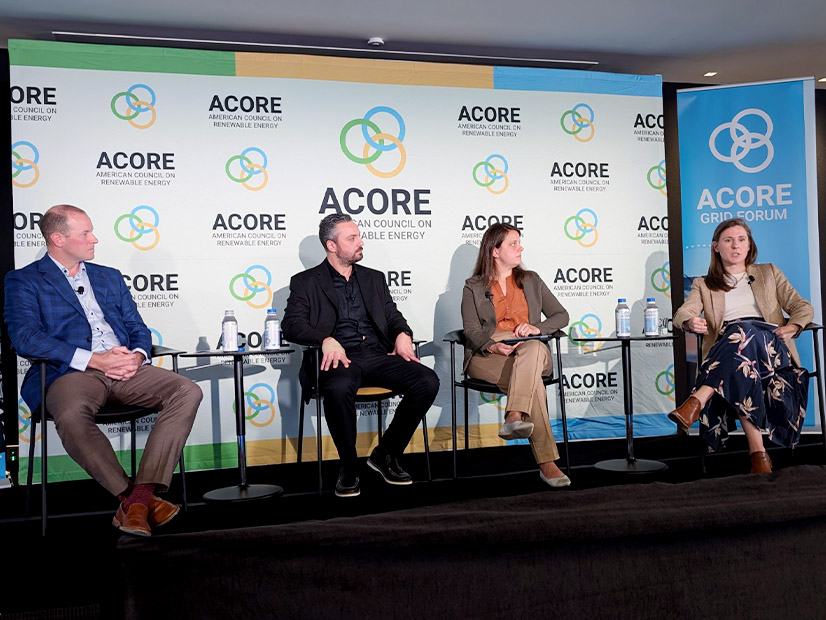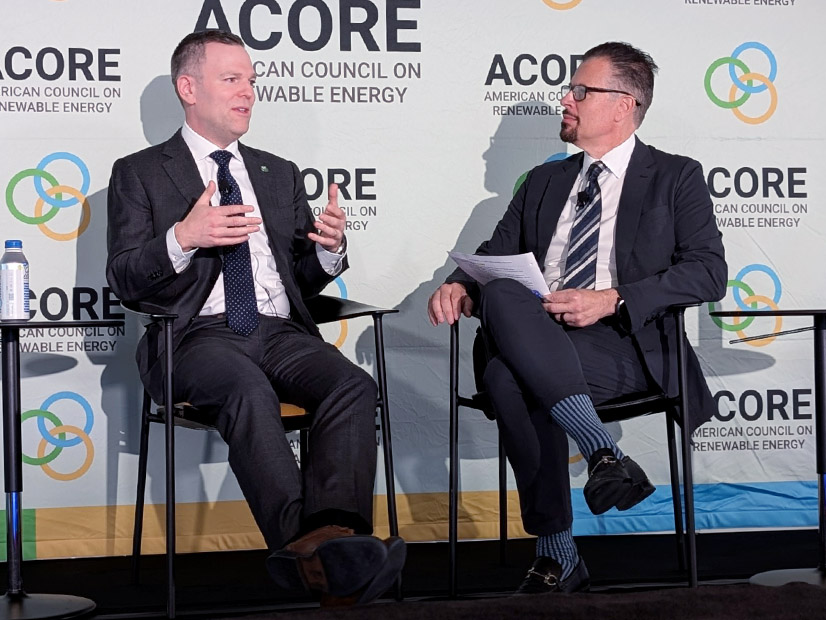
ARLINGTON, Va. ― Order 1920 was a “big lift” for FERC, recalled Liz Salerno, who was lead adviser to former FERC Chair Richard Glick when work on the transmission planning order started in 2021.
“You know, this rule went from an [advanced notice of proposed rulemaking], which was just hundreds of pages of hundreds of questions, open-ended questions, of FERC trying to figure this out, to a detailed proposed rule to a final rule in three years,” said Salerno, who now is a principal with industry consultants GQS New Energy Strategies. “That is lightning speed for a regulatory body.”
FERC’s rule on long-term transmission planning was, predictably, a recurring theme at the American Council on Renewable Energy’s (ACORE) Grid Forum on Oct. 10. But while calling the order a big step forward, Salerno and other speakers urged broad and ongoing industry engagement, stressing that compliance and implementation of 1920 likely would take even longer and prove more challenging for the commission, grid operators, utilities and developers.
Industry stakeholders have estimated it may take five to 10 years for the order to have any major effects on transmission planning in the U.S.
Order 1920 is “not a ‘set it and forget it’ type of thing,” Salerno said. “It doesn’t dictate outcomes. It is a framework; it is rules of the road.”
Much work remains, she told the forum. “There are still folks who don’t want transmission to be built,” she said. “They like the status quo. They’re going to be there … voicing their opinion, and so you need to be there, making sure this thing gets implemented.”
Approved in May with a 2-1 vote, Order 1920 requires RTOs and ISOs to undertake long-term transmission planning ― with a 20-year time frame ― taking into account anticipated load growth, state laws and generation retirements, while also looking at seven core benefits of new transmission, such as cost savings and fewer outages. The long-term plans must be updated every five years. (See FERC Issues Transmission Rule Without ROFR Changes, Christie’s Vote.)
The order also calls for grid operators to open a six-month process to allow states to develop new cost allocation methodologies or adopt one or more “ex ante,” or default, methods for cost allocation filed prior to any selection of projects.
The order has triggered dozens of requests for rehearings, which FERC is considering. Eleven legal challenges have been filed across the country but recently were consolidated to the 4th Circuit U.S. Court of Appeals in Richmond. (See FERC Order 1920 Sees Wide-ranging Rehearing Requests) .
Since 1920 was approved, former Commissioner Allison Clements has left FERC, and three new commissioners have come on board, including David Rosner, who also weighed in on the order during an onstage conversation with ACORE CEO Ray Long. Rosner said he will look for ways to “turn down the temperature ― the political temperature that some people think this rule is taking ― in ways that are directionally consistent with what the rule is trying to do, which I firmly believe … is [that] we’ve got to find ways to build needed transmission.”
Drawing on his experience as an energy industry analyst at FERC and as an adviser to the Senate Energy and Natural Resources Committee, Rosner described himself as “an energy nerd.”
“Like I live in the dockets,” he said. “And what that means is, I still read the orders. I read the comments. That helps us to get to good decisions.”
Industry comments are “foundational” in the commission’s decision making, Rosner said.
While providing no details on FERC’s pending decision on a 1920 rehearing, Rosner was “hopeful that there are a number of things in that record that we can do that achieve those goals, and I am also hopeful that we can work with all five commissioners and ideally get a 5-0 [vote].”
Successful implementation, he said, would ensure “that all resources on the grid can provide all the services that they’re technically capable of driving.”
Considering GETs
But Abdul Ardate, director of transmission and interconnection for developer EDP Renewables, said 1920 may not provide the kind of certainty that is a top priority for his company and others in the industry.
The requirement for long-term plans to be re-evaluated every five years “is a double-edged sword because some [projects] could potentially get stuck in re-evaluations every five years, [so] that nothing can get built,” Ardate said.
He pointed to projects EDP has seen utilities or RTOs repeatedly re-evaluate and redesign at escalating costs, with one project going from $3 million to $8.5 million to more than $60 million, with nothing yet built. The cost to customers for the resulting grid congestion and “generation that cannot deliver its energy is just tremendous,” he said.
Ardate was also skeptical of 1920’s provisions calling on RTOs to “consider” grid-enhancing technologies ― such as dynamic line ratings or advanced conductors ― that can increase capacity on existing lines to provide short-term upgrades while longer-term transmission projects are planned.
“I don’t think the language is strong enough to require them to include grid-enhancing technology, not just consider, because I think that’s too loose a definition,” he said. “I don’t think this is going to push the needle on anything short-term in terms of implementing any grid-enhancing technologies.”
Karin Herzfeld, senior transmission counsel to FERC Chairman Willie Phillips, countered that 1920 does “include a requirement for the transmission provider to justify its decision and to be transparent about that decision. So, I do think that component will provide some incentive or give stakeholders some confidence that they have actually reviewed and considered to see whether a grid-enhancing technology might be appropriate.”
The catch here is the amount of discretion the rule gives operators to decide what projects or technologies may be appropriate for their systems and to reopen consideration of individual projects every five years, Salerno said. “There is no requirement in this rule to select anything; that is up to the discretion of the transmission provider.
“That cuts both ways,” she said. “That means there’s no guarantee for any of us that transmission is going to get built … which again goes back to why you have to engage and make sure that this is a good process, and there is a likelihood of selection.”
“We can do all the planning; we can look at all the benefits, all the requirements, but then ultimately it’s up to the states to decide which project is going to get selected or built, or how it’s going to be cost-allocated as well,” Ardate said. “We have to get active on the state level, the public utility commission level, the Department of Energy, even on the FERC level to make sure that we get our voices heard.”
Win a Little, Lose a Little
Cost allocation has long been a major challenge ― if not an outright deal killer ― for some interregional transmission, and both Herzfeld and Salerno emphasized the importance of 1920’s requirement that states hold a six-month engagement period to determine whether they will use a grid operator’s default methodology or come up with one of their own.
They can also opt for a state agreement approach, “by which they can punt a project that gets selected to a future cost allocation,” Herzfeld said. “They can punt it to their future selves to decide cost allocation voluntarily.”
Salerno said the default methodology ensures that once a project has been selected as part of a long-term plan, “there’s a cost allocation method waiting for them. There is no additional work to be done.
“This is going to make sure we don’t have a world where great projects get planned and get through the selection process because they have great benefits and then they go nowhere because no one can agree on cost allocation,” she said.
On the other end, the six-month engagement period could help circumvent permitting challenges, she said. “Giving some control back to the states to let them decide how [a project] gets paid for is critical to bringing them to the table and getting them comfortable and happy with the project, so maybe [it] smooths out the process on the back end with permitting.”
Herzfeld agreed the ex-ante provision will “just absolutely make sure that transmission will be built” and prevent a project from stalling should a single state hold out on cost allocation.
“Everyone always wins a little and loses a little” in cost negotiations, she said. But “when there’s nothing to kick in as a default, everyone wants to win a lot and lose nothing.”
Thinking Outside the Box
Rosner’s appearance at the ACORE forum was his second on Oct. 10, following an early morning on-stage conversation with Jason Grumet, CEO of the American Clean Power Association, at an ACP event. (See FERC’s Rosner Talks Priorities at American Clean Power Association.)
Repeating some of the key points from his ACP appearance, Rosner said job one for FERC is managing the U.S. energy transition, which “means a lot of different things. It [means] where we have markets, be smart. Let’s make sure those markets are sending the right signals to get the investments, the technologies or the attributes that the system needs to be reliable.”
Interconnection is another top concern for Rosner, who pointed to FERC’s Order 2023 on interconnection, passed in 2023, and, like 1920, “will take many more years to get compliance with it and get it working,” he said.
At the same time, Rosner said, “I am very open to thinking outside the box about what other things can speed that up,” such as the use of artificial intelligence to cut the time needed for interconnection studies.
“Anything we can do to move those studies faster is going to help us get through those queues faster, and if it’s something we don’t have to write a regulation on … I’m like all in on that. So, I want to learn more.”



